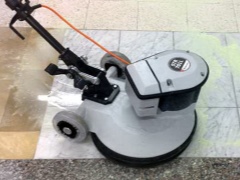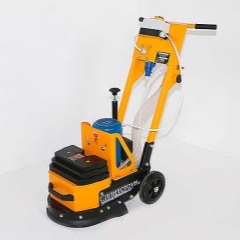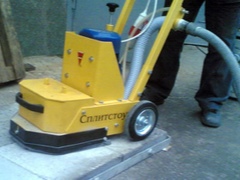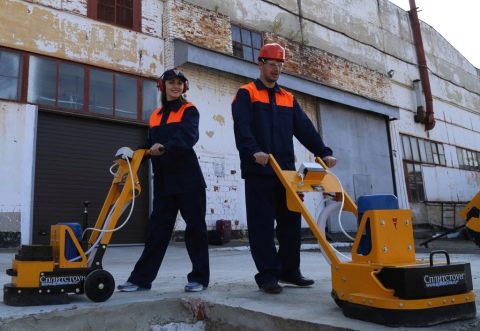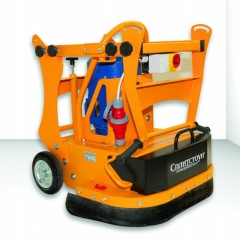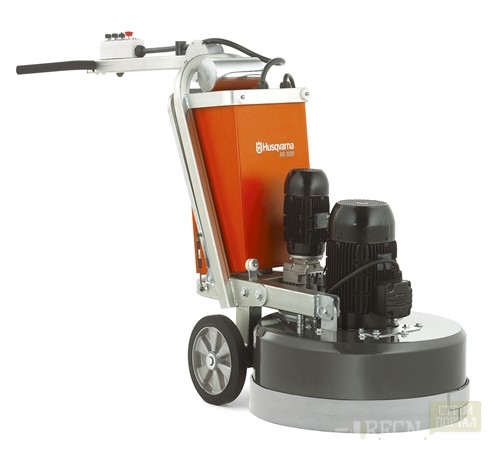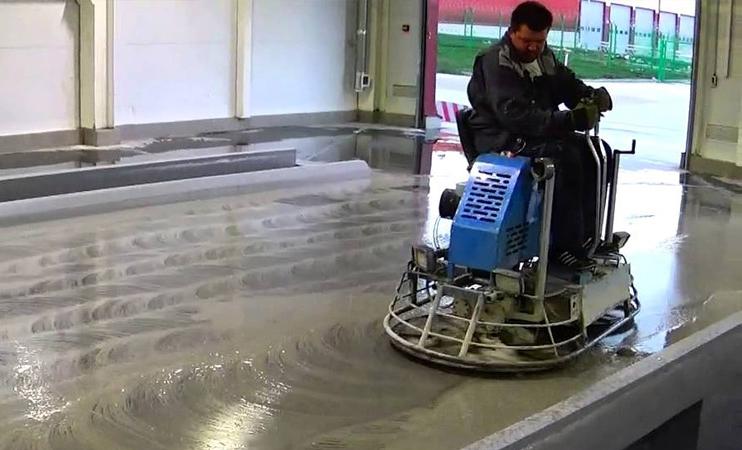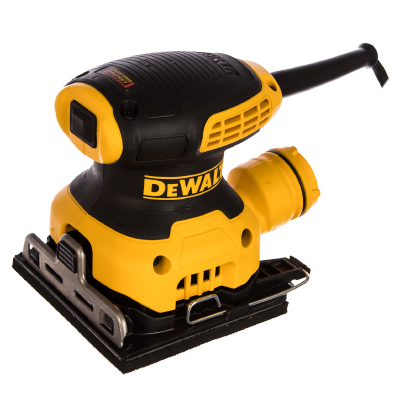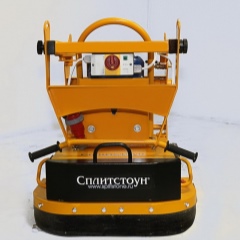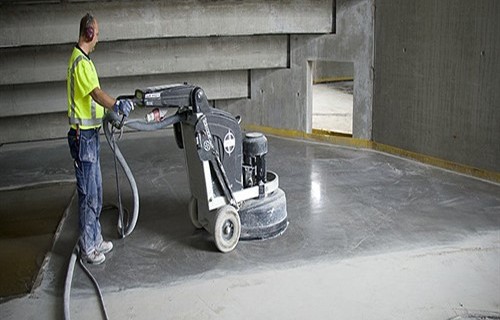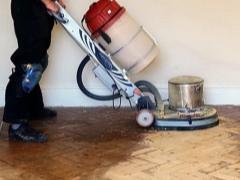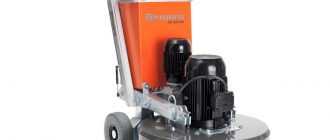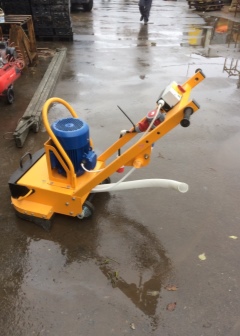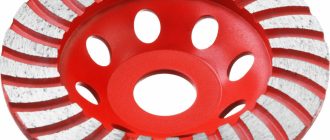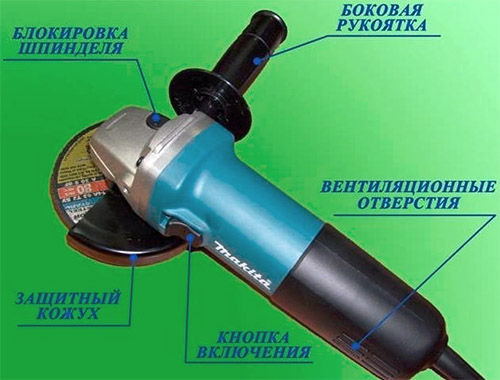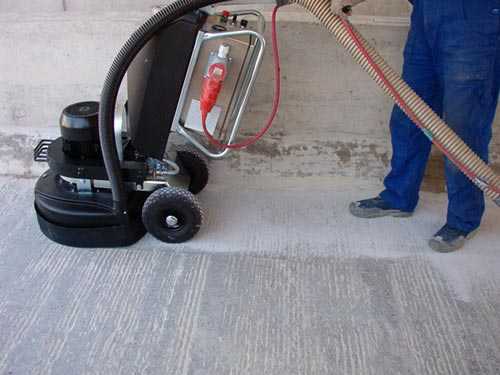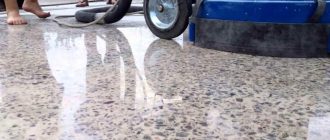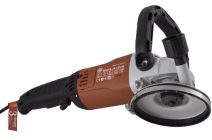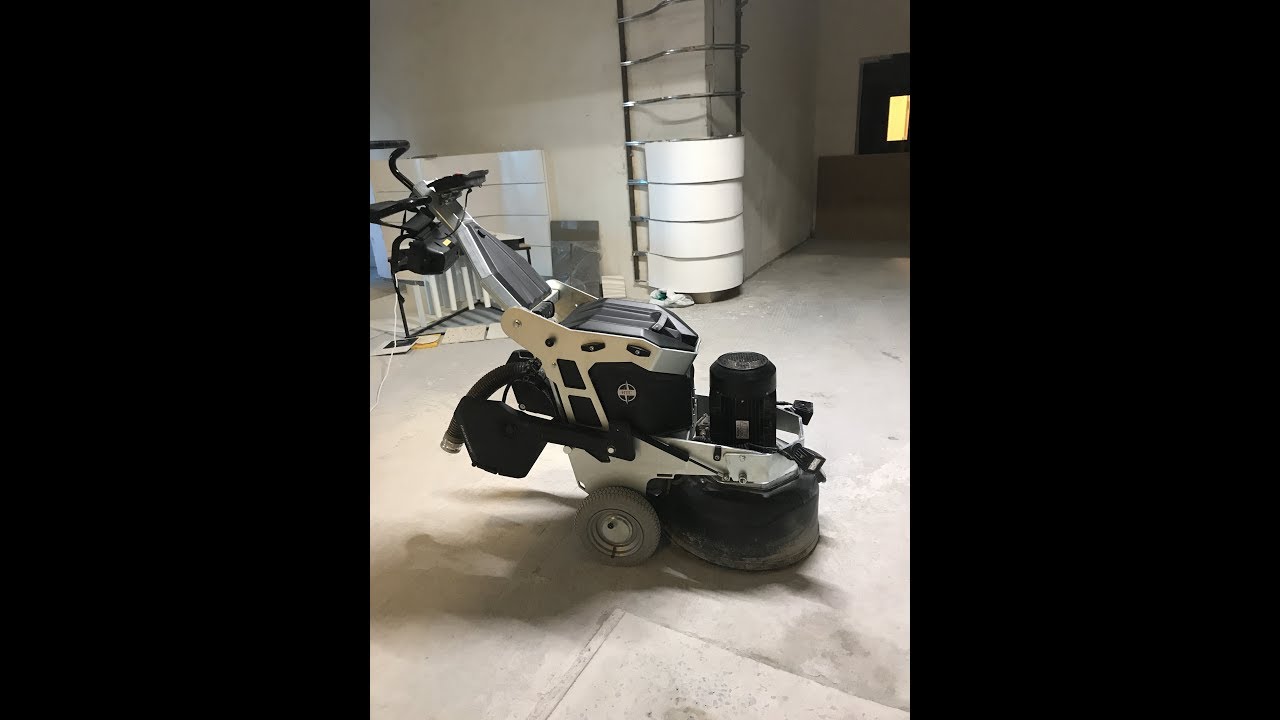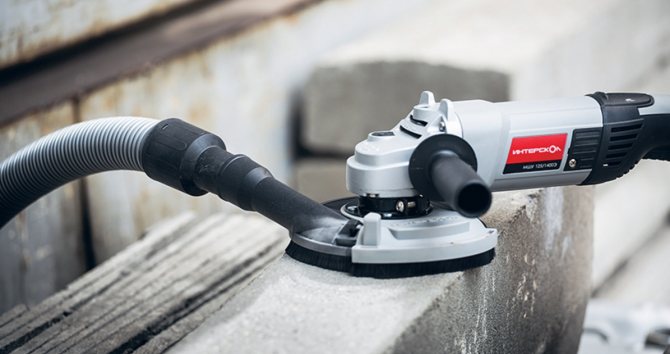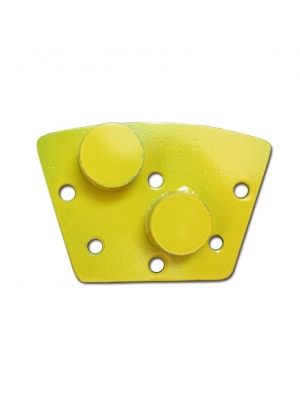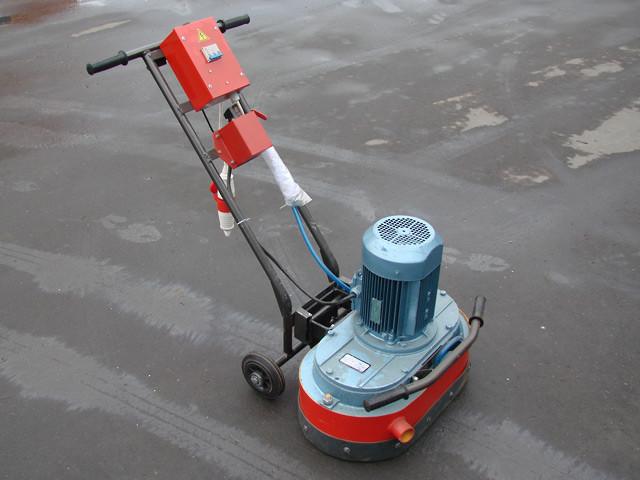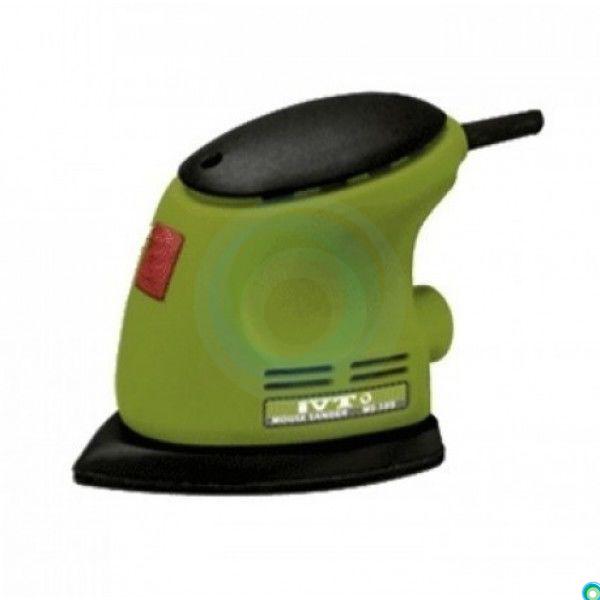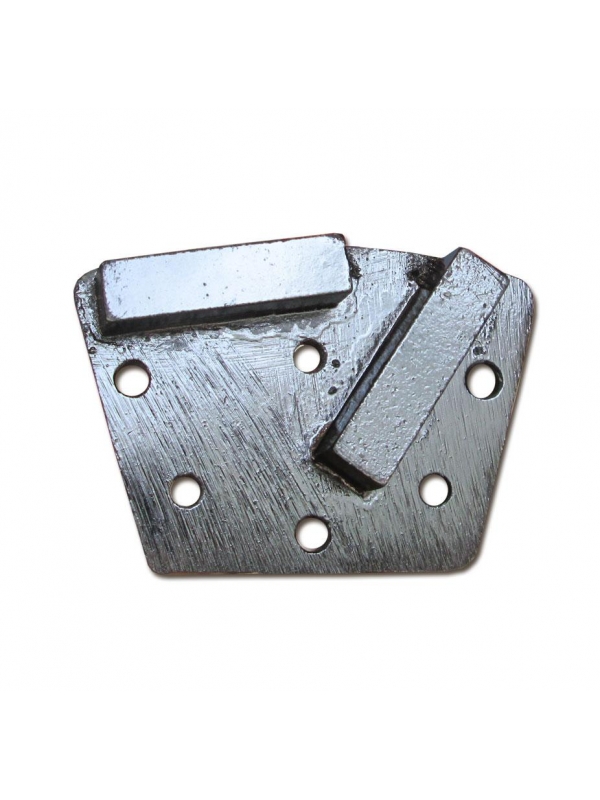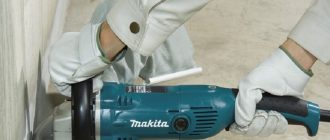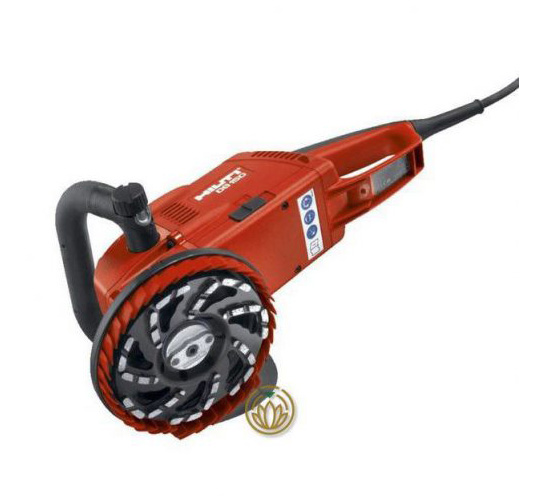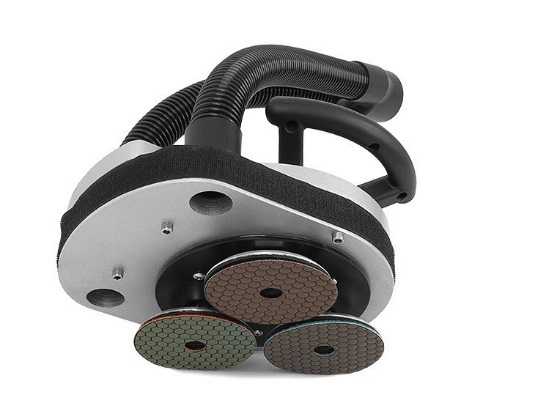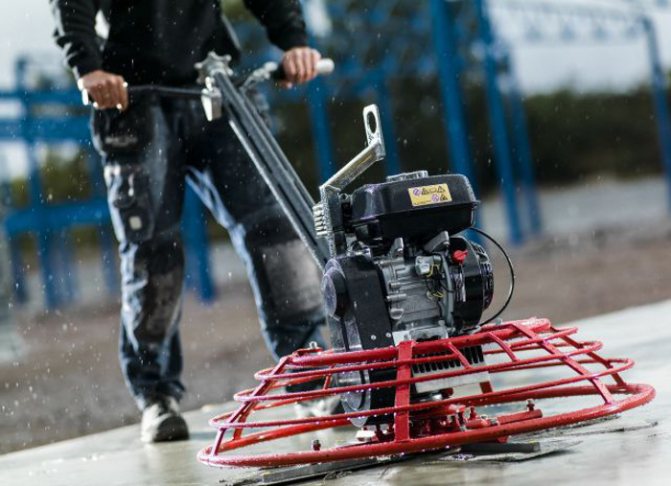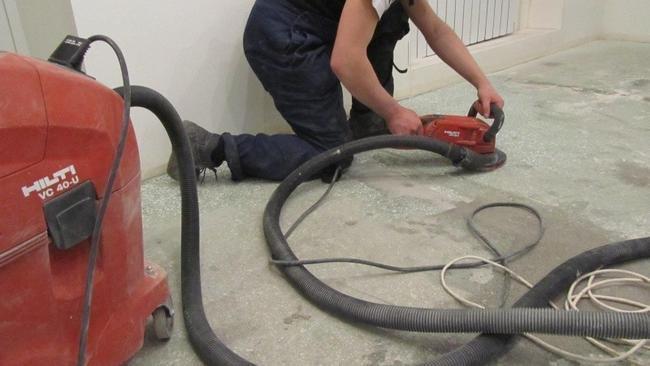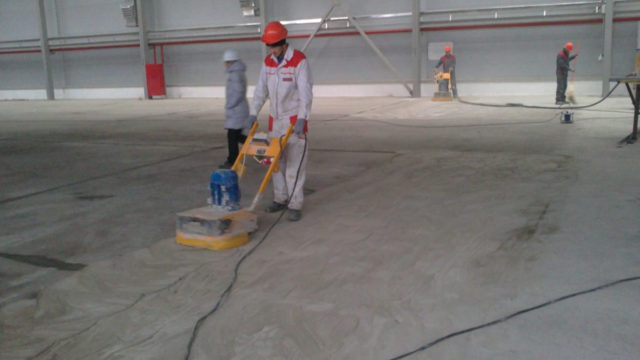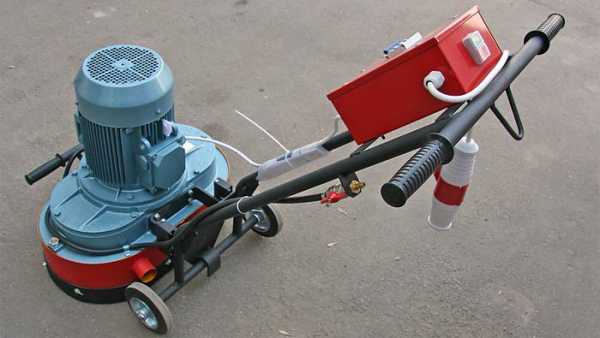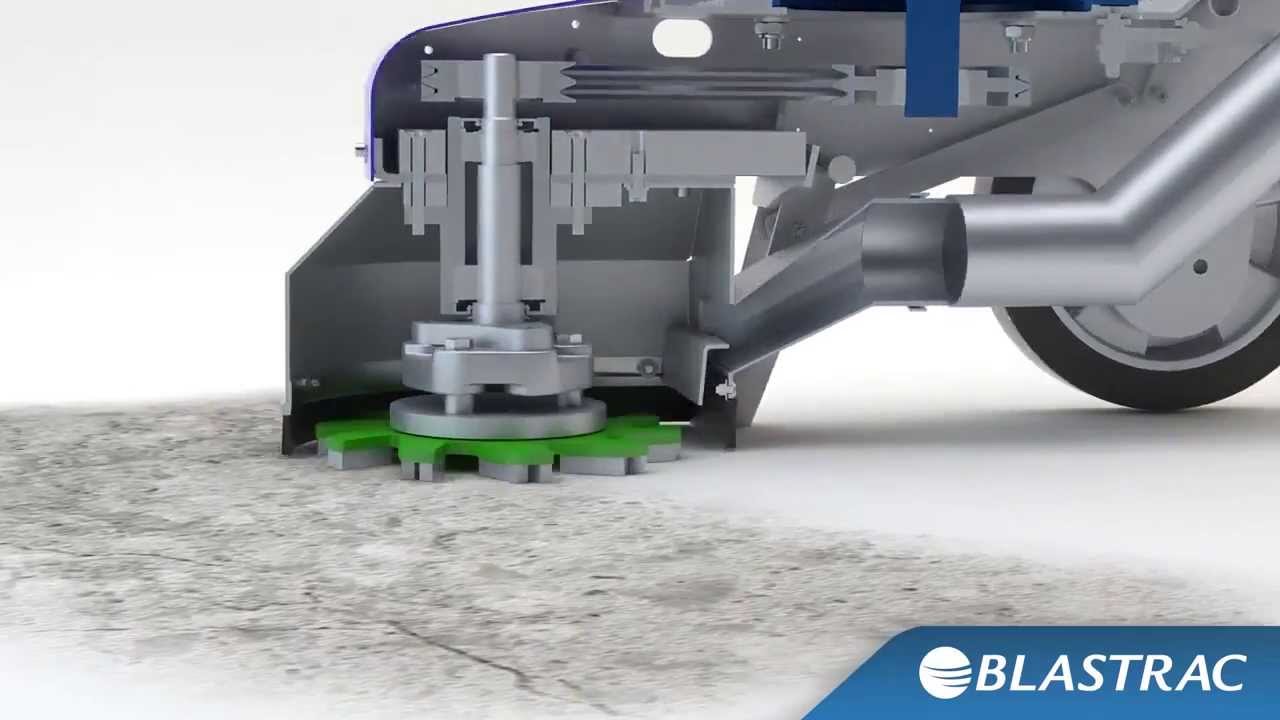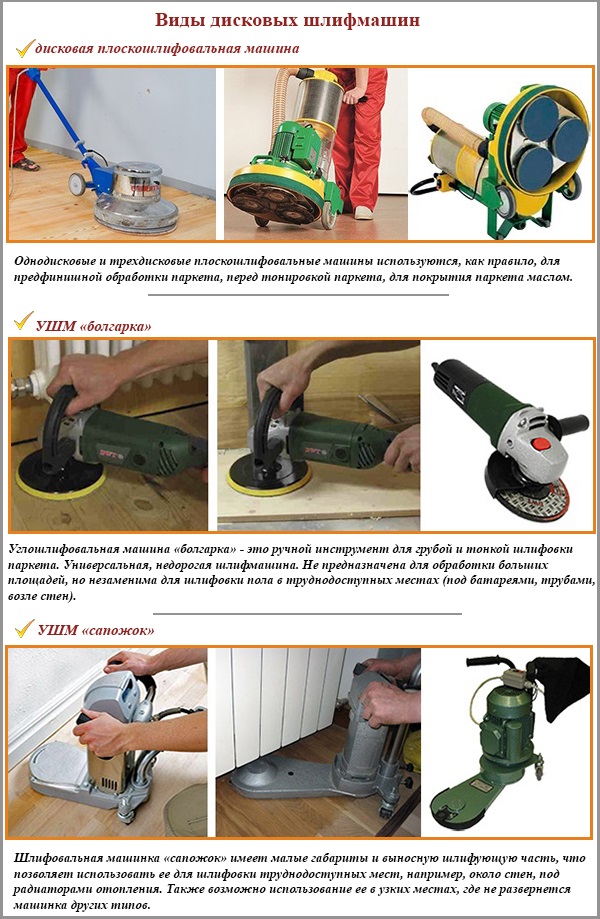Types of grinders
All existing hand sanders are classified according to parameters such as:
- appointment;
- type of construction.
Depending on the purpose and scope of work to be performed, grinders can be:
A household sander is used for small-volume grinding work.
- Household. They are designed for intermittent use and small-volume grinding work. This power tool is low power and not designed for heavy loads. Therefore, when working with it, you must strictly follow the operating instructions supplied with the package.
- Professional. They have significantly more power, which allows them to be used for long and intensive work.
- For sanding screeds. Unlike the tool presented above, such equipment is intended exclusively for processing concrete substrates. With their help, you can grout the joints, as well as eliminate other defects in the concrete screed.
- For grinding stone. They can be used not only for concrete, but also for stone and asphalt surfaces. Metal brushes can be installed in such equipment.
By design features, a concrete grinder can be:
Diagram of an eccentric sander.
- Angular. It is used for cutting and cleaning metal, stone and other products. In everyday life, it is often called a grinder. The small size of this tool allows you to grind concrete even in hard-to-reach places (in corners, under radiators, etc.). Some models are equipped with an anti-vibration function that eliminates vibration caused by uneven wear of the grinding wheel.
- Tape. This hand-held concrete grinder is used for primary (rough) processing of concrete surfaces. Its design is similar to a tractor track: the abrasive belt moves along special rollers, as a result of which grinding is carried out. The speed of work is mainly dependent on the size of the abrasive particles.
- Vibrating. As a grinding element, abrasive sheets of various grain sizes are used, which are fixed on the sole of the device. When performing finishing work, the working element moves in a vertical direction with a small amplitude, but with a very high frequency, on which the speed of surface treatment will depend. This sander is mainly used for finishing.
- Eccentric. Its working surface vibrates and rotates at the same time, which ensures better concrete grinding. The cleanliness of the work largely depends on the diameter of the grinding disc: the smaller it is, the better the result will be. However, as the size of the disc decreases, the time of work increases.
- Mosaic grinding. It is used for the treatment of concrete, stone and mosaic floors. It can perform both preliminary treatment of coatings (removal of sagging and other defects), and finishing in order to obtain the desired roughness, as well as polishing the surface of various natural materials.
Advantages and Disadvantages of Concrete Grinding Equipment

The advantages of grinding equipment:
- high quality and speed of surface preparation for further finishing works;
- a variety of nozzles that allow you to get a surface with a very different degree of smoothness;
- when grinding concrete, the maximum level of errors does not exceed 2 mm;
- wide range of equipment;
- ease of use;
- long service life.
Despite the fact that grinders can perform a variety of functions and have many advantages, they are not without certain disadvantages. Most of them can only be detected during the operation of the equipment.
Among the most significant shortcomings, it should be noted:
- impressive costs for consumables;
- the formation of a fairly large amount of dust during surface treatment.
The list of advantages and disadvantages, depending on the type of the selected machine, can be supplemented with new sub-items, since each model has its own operational characteristics.
Grinder types
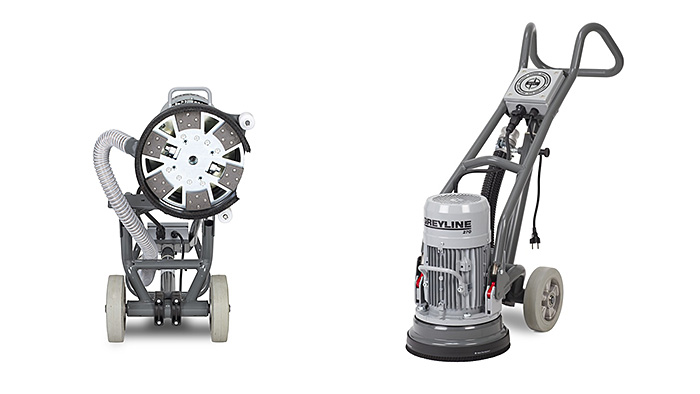
The scope and functionality of the grinder is largely determined by its type of construction.
Modern grinding machines are divided into:
corner. Such machines are used for rough processing, cleaning and cutting of concrete, stone, metal and other hard materials. They have small dimensions, so they can be used in hard-to-reach places (under the batteries, behind the risers). Angle grinders do not have a system that allows you to adjust the speed of the cutting disc. Some models may have an auto-balancing function of the disc, which allows you to control the vibration of the tool that occurs when it is unevenly worn;
tape. Machines of this type are used for stripping and rough processing of materials with a hard, but not very dense structure. Coarse-grained emery tape acts as a consumable for this equipment, which makes it impractical to use it when processing large concrete floors;
vibrating machines are characterized by good maneuverability, light weight and reasonable price of consumables. Most often, vibration grinders are used to process small areas before finishing. Consumables in vibrating machines are attached using Velcro or special clamping devices. Attaching with Velcro is quite an expensive option, but significantly reduces the time for tool changes during grinding. Fixing the instrument with clamps, although it takes some time, makes it much easier to choose a replacement than with Velcro. A variety of vibratory units are delta grinders. Their working surface looks like an iron and protrudes beyond the body. This allows delta machines to be used in hard-to-reach places;
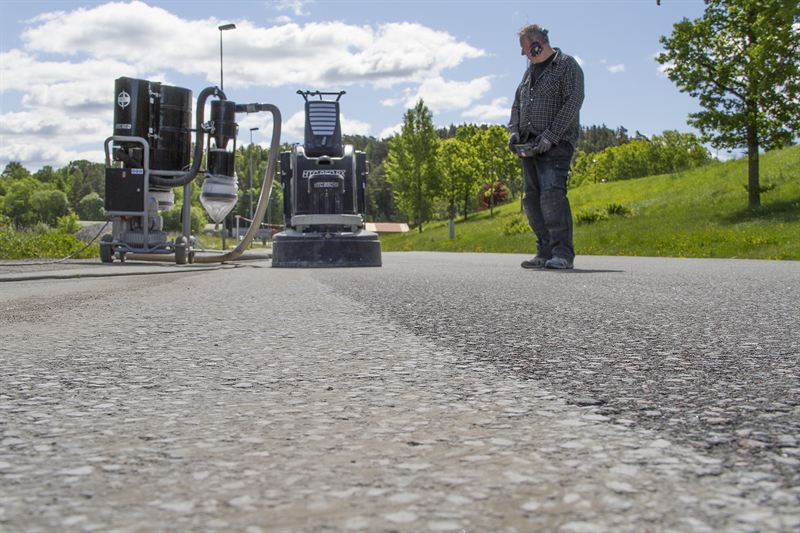
orbital (eccentric) machines. Grinding of concrete is carried out due to the rotational movement of the working discs, combined with a reciprocating motion, which is provided by an orbit displacement by 3-6 mm. The largest eccentric stroke is used for rough concrete processing, and the small one for finer grinding. In expensive models, the eccentric stroke is corrected. Consumables are fixed in the same way as vibration-type units. Orbital-eccentric equipment is available in various capacities, which allows you to choose a machine for both professional work and for domestic purposes. Almost all models provide for damping of vibration effects on the human body using a special vibration stabilizer. An orbital-eccentric machine will not be able to process corners in a room and other hard-to-reach places, but many models are equipped with dust bags and the ability to connect a vacuum cleaner;
Mosaic grinders are used for leveling, grinding and polishing a monolithic base made of ordinary, reinforced or decorative concrete. Machines of this type belong to the category of the most expensive grinding equipment. Unlike other types of grinding units, the structural units of mosaic machines are much better protected from dust, and many models are equipped with a vacuum cleaner.The consumables for these machines are cups and cutters with carbide or diamond segments. But all the advantages of mosaic grinders affect both the cost of the equipment itself and the cost of the accompanying consumables;
trowels ("helicopters"). These machines compact, level and sand the concrete floor immediately after pouring. They got an unusual name due to the rotating blades. Their principle of operation is based on double processing. At the first stage, a rough grinding of the plane is performed using disks attached to the blades of the helicopter. As a result of processing, a smooth and uniform surface is obtained. This is followed by fine grinding. At this stage, only the blades of the machine are working.
Thus, when choosing a grinder, one should evaluate the need for various functions that increase the price of equipment, as well as the type of attachment of the working tool, with the help of which the surface of the concrete floor acquires the required degree of smoothness and a number of other criteria that affect the performance of the machine.
What to look for when choosing a tool
When choosing a grinder, there are a number of points that you need to pay attention to. Next, we will look at the main ones.
Power
The productivity of the tool depends on this parameter, since powerful machines can work continuously for longer. However, as mentioned above, they are more expensive, weigh more and are more energy intensive.
The power of the grinding machines ranges from 600 to 3000 watts. It does not always make sense to purchase a powerful tool, for example, for small amounts of work "around the house", a grinder for grinding concrete with a power of 600-1000 W will be enough. If it is planned to process large areas, then you will need a more powerful concrete grinder - 1500 - 2000 watts.
Diamond disc cup
Maximum disc diameter
The area of the treated surface depends on this parameter. If a grinder is purchased, which will be used for different purposes, for example, it is planned to cut reinforced concrete with diamond circles, then the maximum cutting depth will also depend on their diameter.
All discs are divided into three types in terms of diameter:
- Small - 150 mm
- Medium - 150 - 200 mm
- Large - 250 mm.
Spindle thread
The size and thread of the spindle determines which discs the device can work with. The most common size is M14. However, you can also find on sale models with a spindle size of M16.
It should also be borne in mind that the labeling is different for different manufacturers. There are no uniform standards.
Working area
The speed and convenience of processing depends on the size of the working area. The larger the working surface, the correspondingly less time and effort will have to be spent on surface treatment.
In concrete grinders, the working surface is interconnected with the maximum disc diameter.
Additional handle for manual clipper
Equipment
When choosing a tool, it is imperative to pay attention to additional equipment, since the ease of use and versatility of the device depends on it. TO additional equipment include:
Additional equipment includes:
- Handle - helps to reduce vibration and distribute the force correctly when using the tool. In some models, the handle is rigidly fixed, and in some it can be adjusted.
- The speed stabilization system is able to fix a certain frequency required by the operator, regardless of the applied load on the tool. This system allows you to maintain the performance of the device during operation.
Sanding with a dusting machine
- Dust collector - as you might guess, this option is to collect dust generated as a result of grinding. Typically, a concrete grinder has a sealed container or bag that can be built into the body or removable.
- Infinitely variable speed control - using this function, you can configure the machine to work with different materials, not just concrete.
- Battery operation - this option is important when you have to do work in the absence of electricity. Such machines are especially convenient for household purposes when their short-term use is required. However, the disadvantages include the high cost of batteries and a limited time of continuous operation.
Apparatus with a water supply system
- Water supply - thanks to this option, the device can be connected to a water source, as a result of which the liquid will be sprayed onto the working area. This will reduce the level of dust and increase the uptime of the device. Almost all professional machines have this function.
- Start Button Lock - Increases device security by preventing accidental start-up of the device. In addition, this option allows you to keep the device turned on, which makes the tool more convenient, since you do not have to hold down the button for a long time.
Manufacturer
When choosing a manufacturer, of course, it is better to give preference to well-known, well-proven brands.
These include:
- Bosch;
- Makita;
- Stern;
- AEG, etc.
Dust bag machine - Makita
To perform household tasks, you can pay attention to tools from manufacturers such as:
- Sparky;
- Einhell;
- Proton, etc.
These are, perhaps, all the main points that you need to know when buying a sander.
Classification by type of movement
Grinding, or mosaic, machines are divided according to the mode of movement:
- Manual, when the operator moves the mechanism himself.
- Self-propelled, movement is performed by an electric motor or an internal combustion engine through a gear train.
- There are hand-held devices without a drive for treating walls, columns and ceilings. They are lightweight, which makes them easy to handle. Equipped with a small electric motor that rotates the abrasive material. The machine has handles for convenient use.
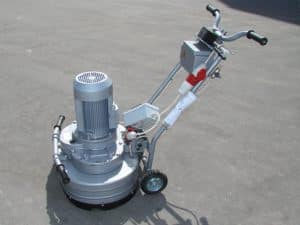 Grinder for concrete floors.
Grinder for concrete floors.
For movement, the mechanism with a manual or automatic drive is equipped with wheels, they are located on the frame. Devices with a manual drive can have 2 wheels, with an automatic drive there can be 4 or more. Some designs, especially those with an automatic drive, have steering wheels, which allows the machine to be turned almost on the spot. The control panel can be stationary or remote, in the latter case the operator can be at some distance from the working mechanism.
Mostly machines with electric motors are used, they work with less noise, have more functionality, and require less maintenance. The main disadvantage is the dependence on the availability of a power source and the use of electrical cables.
What to look for when choosing
When choosing machines for grinding concrete, the tasks that will have to be solved with their help are taken into account. The main parameters are selected for this: power, speed and working diameter of diamond cutters or moving elements of belt structures. Depending on the scope of work, it is determined whether a manual or industrial concrete sander is required.
When choosing a manufacturer, it is better to opt for popular brands. The most famous machines are Makita, Bosch, Stern, AEG. Many Chinese manufacturers have sprung up, especially small hand-held grinders.They offer a low price, but to be sure, it is advisable to read reviews on trustworthy resources or ask experts. It is better to buy in stores that give a guarantee for the equipment.
Concrete grinders with a power of up to 1.8 kW are classified as manual models with increased maneuverability. They are convenient for treating any surfaces, but in order to avoid overheating, it is required to take breaks every three hours of work. Devices up to 5.5 kW are bulkier and heavier and can withstand prolonged wet and dry sanding. They cover a large area, which increases the speed of concrete grinding.
On manual machines, discs up to 230 mm are used, the processing speed will depend on the diameter. For fine grinding and polishing, 125 mm discs are selected, the joints are cleaned with discs up to 180 mm. On hand-held models, the handle must be firmly fixed to clearly guide the cutting edge.
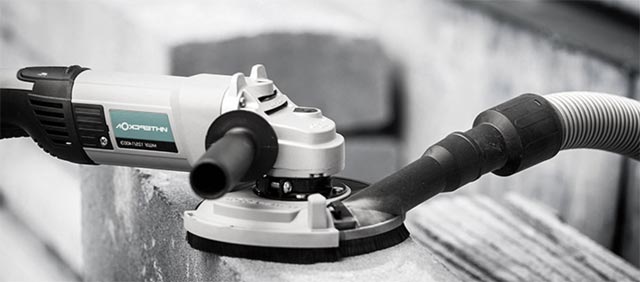
Coarse grinding of concrete is done with machines operating at around 300 rpm with coarse abrasives. Polishing units have a rotation speed of up to 50 thousand revolutions per minute, bringing the surface to an ideal state, they are equipped with small diameter discs. Ideally, it is best to operate with variable speed concrete grinding equipment to enhance its operational capabilities.
When working with walls and ceilings, select machines with the lowest weight. At the same time, it is taken into account that they will not have sufficient power, therefore, technological breaks are required.
Additional elements such as water pumps and dust collectors will significantly simplify the work and maintain the performance of the device, protecting its mechanisms from moisture and dust. They can be built-in and external, for example, hand-held grinders are equipped with nozzles for connecting industrial vacuum cleaners. Their use makes work safer, since cement dust, settling in the lungs, causes great harm to the human body.
A properly selected grinder will allow you to quickly and efficiently process any area with minimal waste. It will ideally polish concrete or prepare it for further processing and coating with layers of plaster, polymer or other compounds that strengthen the top layer and give it a finished appearance.
Types of mosaic machines
In order to reduce the fatigue of the worker in the process of grinding the floor, more modern models have been used. Domestic devices of the Splitstone brand are very popular. The company has been making various construction vibration tools for a long time. All products are equipped with a Frankfurt mount to accommodate the abrasive tool. Fastening is carried out in the form of a special seat on the working head for the installation of abrasives of various configurations. Thanks to this solution, the risk of accidental skewing of the grinding attachment when processing stone or concrete is reduced. In addition, it greatly simplifies the process of changing parts. Today there are several types of mounts - Professional and Standart.
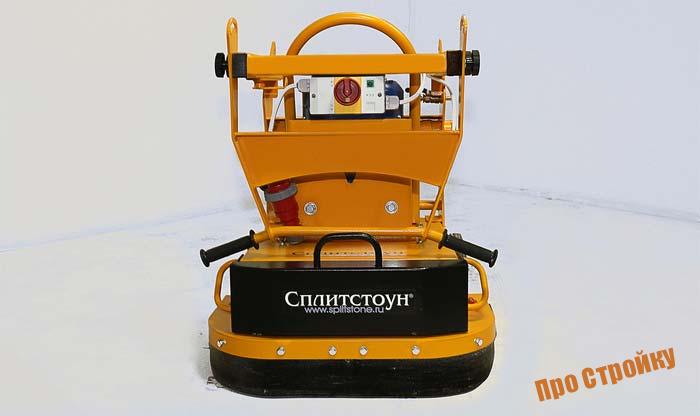
Among the small mosaic grinders, it is worth stopping at the Splitstone GM-122. The model allows you to sand surfaces up to 305 millimeters wide. The 4 kW electric motor enables the abrasive tool to rotate at 1100 rpm. At the same time, the standard productivity of the tool when working with concrete is about 50-60 square meters at a time. There is an opportunity for joint work with a construction vacuum cleaner.
If you need a more powerful unit, you can pay attention to the two traverse model of the same brand - GM-245, which stands out for the greater power and performance of the engine. So with a power of 5.5-7.5 kW, the speed doubles!
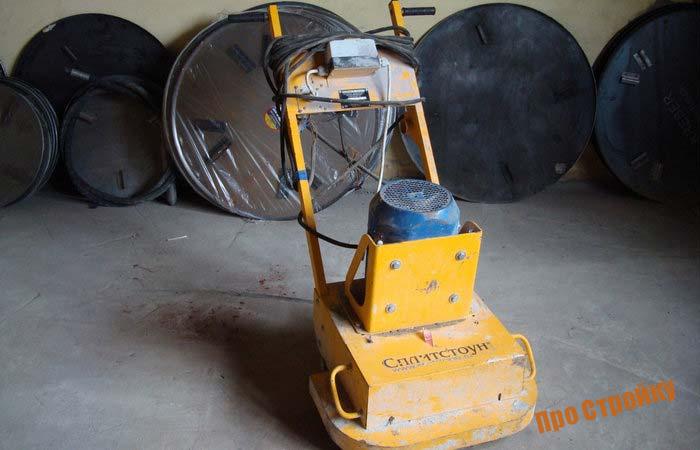
The self-propelled mosaic grinder has several design changes, one of which is the presence of a second drive, which provides higher mobility, turning and a larger swath. For example, the HTC 1500ixt is equipped with a different motor with an internal power source, which significantly increases the mobility and autonomy when sanding concrete floors.
Floor surface polishing
The concrete floor is polished in several stages using diamond tools, in particular polishing discs of different grain sizes. The polishing process is carried out on mosaic grinders using an industrial vacuum cleaner.
Stage 7
Concrete polishing with diamond tools
First, the surface is polished in 50 Grit segments - removing excess dried composition. It is necessary that the process is completely dry, otherwise there will be high and premature wear of the diamond tool.
Complete removal of excess composition is necessary to avoid the following problems:
- dark brown unsightly matte stains on the floor after polishing with dry synthetic cups;
- the floor becomes slippery when it comes into contact with water.
Stage 8-11
Concrete polishing with polymer-bonded diamond tools
Next, the concrete surface is polished in stages in order in segments with a grain of 50 to 400 Grit (50 Grit, 120 Grit, 200 Grit, 400 Grit).
Stage 12-13
Concrete polishing with diamond tools
Finally, the concrete floor is polished in 800 Grit or 3000 Grit segments, depending on the type of finish and the desired end result.
The installation of the polishing discs on the sander is carried out by using a special support polishing disc with Velcro. "Diamond turtles" are installed on each carrier disc.
Types and description
Concrete grinding equipment is an indispensable tool for the builder. Only with its help it is possible to achieve the required smoothness and quality of the concrete surface before its finishing. Below is the most common classification of this type of equipment, depending on the purpose and type of construction.
By type of destination
Household concrete grinders
This category of tool is suitable for small amount of grinding work, for example, for repairing a house or in the country, when building your own house. As a rule, such models are not endowed with high power indicators, therefore they are not designed for heavy loads.
When working with household machines, it is important to follow the instructions exactly to avoid unwanted damage.
Professional technique
The tool of this type is distinguished by high power indicators, therefore, it is capable of processing large areas. With a professional machine, work can be carried out as long as it is required at different intensities of use. As a rule, a professional grinder is recommended to be used by construction firms performing large-scale work on the construction of buildings and structures for various purposes.
For leveling the screed
With such a grinder, as a rule, they eliminate defects in the concrete floor, grout the joints. The tool is also characterized by high power, however, it has an extremely narrow focus in use, that is, it is used exclusively for leveling concrete screed.
For grinding stone
The type of tool is ideal for leveling concrete, stone, asphalt surfaces such as roads, sidewalks. For this, special metal shields are installed on the machine.
By design method
In addition to the application, design parameters are used to classify grinders. Below are the most common models.
Angle grinders
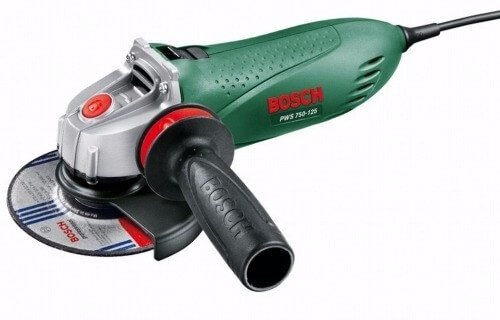
Bosch angle grinder.The main purpose is cutting and cleaning metal, concrete, stone products. The second name of the model is Bulgarian. A feature of the tool is its dimensions. Due to their small size, angle machines can be used in confined spaces, in hard-to-reach places, in corners. Models equipped with anti-vibration mechanism are also available. This function allows you to eliminate vibration that occurs when the grinding wheel does not wear evenly during operation.
Tape model
This type of concrete sander is intended for manual use. The main field of application is primary, that is, rough, polishing, for example, to remove surface imperfections made when pouring concrete. Manual grinding is carried out with an abrasive belt on rollers, similar to a tank track. The grinding speed is determined by the size of the abrasive element.
Vibration technology
Models of this class are ideal for high-quality pre-finishing of the surface. In the role of a grinding element on machines, abrasive sheets with different grain sizes are used, fixed on a special sole. In the process of processing, the speed of the working element is determined by the frequency and amplitude of its work.
Eccentric or orbital machines
With the help of such a machine, a very high-quality finished surface can be obtained. Efficiency of grinding is achieved through the use of vibrational and rotational movements of the working element, performed simultaneously. The disadvantage of this tool is the duration of work when using grinding wheels with a small diameter.
Mosaic grinding equipment
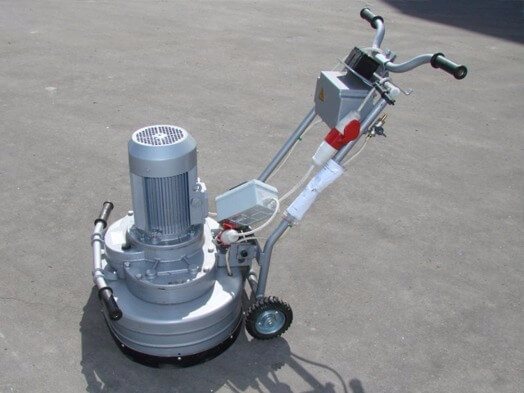
Mosaic grinding equipment. This category of machines is used for grinding cement and stone surfaces, in particular for working on mosaic floors. The tool is used for pre-treatment to remove sagging and other imperfections in concrete. Also, grinding equipment copes well with finishing stone and polishing. The machine is equipped with discs for obtaining rough surfaces with high adhesion to adhesives.
User manual
Before using a mosaic-type grinder, it is imperative to make sure that all its mechanisms, assemblies and parts are working, check the reliability of the fasteners, and also clean the surface to be treated. After that, the machine is installed on the surface to be treated, a traverse is set in it and all the necessary communications are connected - a special pump and a hose with a water supply mechanism to moisten the surface. Grinding on a typewriter should be used for concrete screeds, the height of which exceeds 3 cm. The maximum allowable height difference is 5 mm.
Before the start of grinding, the concrete coating is treated with a special sealant. It completely closes all existing pores in the material. For work, most often they take discs with a grit index equal to 40. The second grinding is performed with discs with a grit size of about 400, and for finishing grinding, discs with an indicator of 2000-3000 are needed. At the end of grinding, the concrete should be coated with polymer compounds that increase the surface's resistance to various kinds of mechanical stress.
After finishing work, turn off the engine and make sure that there are no extraneous noise and increased vibration. The machine descends into the working position rather slowly.
Please note that the diamond elements should begin to come into contact with the work surface only when the motor picks up the required speed. The unit should be controlled smoothly, without any sudden movements.
At the end of the work, the grinder should switch off.
For information on how to work with a mosaic sander, see the next video.
Types of grinders
The modern industry offers a huge selection of this equipment. These are industrial or hand-held concrete grinders, which are sorted according to two main parameters: purpose and design features.
By appointment
Regardless of the design, machines for processing a concrete monolith are classified according to its purpose. There are several main types, a concrete grinder is:
- Domestic. It is characterized by a relatively low power. Such machines are used for processing small areas. Do not tolerate overload, which is noted in the instruction manual. These units are inexpensive and lightweight.
- Professional. High power, the machine works continuously for a long time. It is used for concrete floors and other screeds of a large area, equipped with additional devices for wet and dry grinding, suitable for all types of concrete. They have relatively large dimensions and weight, which complicates transportation and requires special handling skills.
- For leveling the surface. They are used for grinding concrete floors. They have their own vacuum cleaner or the ability to connect it for dry grinding; for a wet one, a water pump is connected.
- For grinding natural or artificial stone. Will give smoothness to any stone or asphalt concrete. Additionally equipped with metal brushes.
By construction type
This classification takes into account the design features of concrete grinding machines. The most popular models include:
- Corner machines are small and work in hard-to-reach units. These are manual grinders with abrasive discs of different grain sizes. Easy to operate, but not suitable for large areas. Cordless hand held concrete grinders exist, but the high cost of batteries makes the application economically unfeasible.
- Belt grinders for concrete grinding perform the primary processing of the top layer. Sanding is done with a roller belt that effectively removes damage from the surface. To adjust the processing speed, elements with different grain sizes are used.
- Machines with a planetary system of rotation of elements. The simultaneous rotation and vibration of several elements perfectly process the top layer. The use of small diameter discs can delay the work, but the quality will increase.
- Mosaic concrete grinding machines. In addition to stone and concrete structures, this equipment is used on mosaic floors. It is needed to remove defects and increase adhesion for further processing. With a wide range of settings, this machine copes with the polishing and finishing of natural stone.

